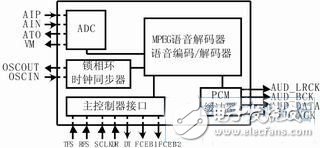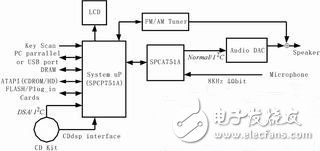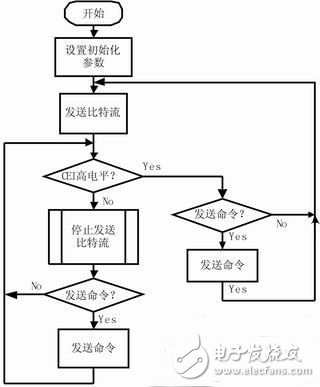MP3 compresses music by removing the high-frequency and low-frequency parts of the sound through an algorithm, which drastically eliminates unnecessary waste of capacity while preserving the audio portion that humans can feel. Therefore, it has the advantage of greatly reducing the capacity of digital sound files without damaging the original sound quality. Under the MP3 algorithm, the lower the sound quality, the higher the compression ratio. For CD-quality Wave files, if the sampling resolution is 16bit, the sampling frequency is 44.1kHz, and the sound mode is stereo, then the Wave file that stores 1 second CD sound quality must use 16bit & TImes; 44100 & TImes; 2 = 1411200bit, That is equivalent to the storage capacity of 1411.2 kbit, the storage medium has a large burden. After compression by MP3 format, the file can be compressed to 1/10 to 1/12 of the original, and the MP3 of each second only needs about U2-128kbit.
MP3 playback systems are available in both portable and non-portable formats. For non-portable, consider compatibility with other CD music formats. For portable systems, the main consideration is its small size, low power consumption, high capacity, and low price.
introduction
Bsp; The system block diagram of the portable MP3 player is shown in Figure 1. The functions of each part are as follows:

Figure 1 Portable MP3 player system block diagram
1. Decoding part: This is the core component of the MP3 player, using hardware decoding technology.
2. Storage: At present, 32MB of FLASH memory is generally used. 32MB of memory can store music of 128kbps (CD quality) for 36 minutes. If it is 16kbps compressed voice, it can store 4 hours of content.
3. Interface part: MP3 files are generally downloaded through the parallel port or USB port of the PC. The transmission rate of the parallel port is low, and the transmission rate of the USB port can be as high as 12Mbps.
4. Power Management: The portable MP3 is small and powered by only one or two AAA batteries, so low voltage and efficient power management are essential.
Audio decoding chip internal structure
SPCA751A is a single-chip signal processing chip produced by Sunplus Technology Co., Ltd. It is an MPEG Layer 2.5 audio dedicated decoding chip, which has been widely used in some portable MP3 player designs. It can support the decoding of 8-320Kbps basic data stream, and supports sampling frequency range from 8KHz to 48KHz. It is very suitable for MPEG audio decoding, and has MPEG playback module with digital voice recording. It has high performance/price ratio. . The decoded signal is a stereo, mono or dual channel digital signal that can be output directly to the DAC. The interface between the SPCA751A and the DAC is programmable. The system controller can easily decode MPEG audio signals by input/output and playback control of the MPEG bit stream through a universal serial I/O port and control interface. A decoded audio PCM data can be output to an external DAC through a universal programmable I2S interface. Therefore, most commonly used audio DACs are compatible with the SPCA751A.
For embedded voice recording, the SPCA751A features a high quality 10-bit 8KHz sampling frequency ADC. Based on the SACM_S480 or SACM_S3200 algorithms, speech can be compressed to 4.8Kbps and 32Kbps, respectively, while maintaining the original speech.
The SPCA751A uses a power supply of 3.0V to 3.6V, which can be synchronized with the system clock from its own 16.934MHz crystal through a phase-locked loop. The SPCA751A signal processor can operate at up to 34MHz with low power consumption, making the SPCA751A ideal for portable systems.
The internal function of the SPCA751A chip is shown in Figure 2. The main controller has enough I/O ports, can access the flash memory and drive the LCD.

Figure 2 SPCA751A internal function diagram
To suit the needs of digital recording applications, the SPCA751A has a sigma-delta ADC suitable for the speech band. The converter circuit consists of two main modules: an ADC module and an internal reference bias voltage module, the latter being a 10-bit harmonic 15-bit data format for sound.
The ADC module includes a microphone amplifier, a programmable gain amplifier (PGA), an analog oversampling regulator, and a decimal data filter. The PGA gain can be from -12dB to 12dB (-12, -6, 0, 6, 12dB). When the oversampling signal frequency is 1.024MHz, the regulator is a sigma-delta feedback loop that completes the differential analog signal input to the pulse. Density adjusts the conversion of a single-bit digital signal output.

Figure 3 MPEG audio player system block diagram
CEI indicates whether the main controller can receive data setting initialization parameters: IDF + 512 bytes data setting bit stream: ID6 + 512 bytes bit stream setting command: ID (lower byte) + command (high byte)
hardware design
The SPCA751A is a monolithic CMOS microprocessor that is a dedicated chip for real-time MPEG audio decoding and voice recording. The main processor controls the SPCA751A to decode the MPEG voice data through commands of the serial control port/I/O interface, and the main processor can also detect the decoding process according to the interface. The block diagram of the MPEG audio player system is shown in Figure 3. The connection between SPCA751A and the main controller is shown in Figure 4.

Figure 4 SPCA751A connection to the main controller
software design
The SPCA751A works in two modes, MP3 mode and Digital Voice Recording (DVR) mode. In the MP3 mode, the SPCA 751A decodes the input bit stream and transmits the data to the SPCA 751A as input data. When FCEB1 is high (default), the host processor sends a bit stream to SPCA751A; when FCEB1 is low, it indicates that SPCA751A is busy, at which point the host processor cannot send any data to SPCA751A. In DVR mode, SPCA751A encodes/decodes the entered digital bit stream. If FCEB1 is high, the main processor can receive data from SPCA751A. When FCEB1 is low, the main processor cannot obtain bit stream from SPCA751A. The flow chart for programming SPCA751A is shown in Figure 5.

Figure 5 Flow chart of SPCA751A programming
Conclusion
MP3 uses a relatively complex technique to achieve better compression, and the sampling rate of wideband audio signals is also high (generally 44.1 kHz or more), so the amount of computation and data of MP3 codecs are quite large. For example, a decoding program written in assembly language on a fixed-point DSP platform requires nearly 40 Mbps for real-time decoding under 128 kbps, stereo, and consumes 15 kB of program/design space. This is one of the reasons why portable MP3s are currently popular in the market, and similar products that can be encoded in real time are still rare. However, with the continuous improvement of hardware performance and continuous improvement of software algorithms, MP3 real-time encoders will certainly achieve further development.
Ceiling Installation Linear Light is a high-end line of flexible decorative lamp, which is characterized by low power consumption, long life, high brightness, flexible, maintenance-free. Particularly suitable for indoor and outdoor entertainment, the outline of the building and billboard production. Depending on the needs of the products are 12V, 24V, etc., length 30CM, 60CM, 90CM, 120CM the like. Demand may also be customized with different specifications according to customer line lights.
Lamp housings are made of aluminum drawn, sharp lines, simple structure, beautiful appearance, strong, corrosion-resistant, easy to install. Light surface electrostatic spray, high temperature resistance, good weatherability. Imported anodized aluminum reflector plate, ensuring high output light energy. 3MM thick high-strength tempered glass, high transmittance, impact resistance. Built up to ensure protection class IP65. Technical parameters Model: HX-XQ range of colors: red, yellow, blue, green, white and color beam angle: 15 ° -60 ° light irradiation distance: 20 m control system: DMX512 controller or wall washer simple controller case material aluminum connection standard signal power cord connector 3-pin signal connector.
Effect:
Flashing color can be achieved through the 16 million kinds of color change of the static display: Hu Ming, suddenly dark.
Cross-color: color temperature of several alternating intervals.
Chase Change: Several color temperature to catch up with each other.
Flow Function: Single color temperatures regularly circulate.
Ceiling Installation Linear Light
Ceiling Installation Linear Light,15W Ceiling Installation Linear Light,Ceiling Installation Linear Light Waterproof,40W Ceiling Installation Linear Light
Shenzhen Mingxue Optoelectronics CO.,Ltd , https://www.led-lamp-china.com